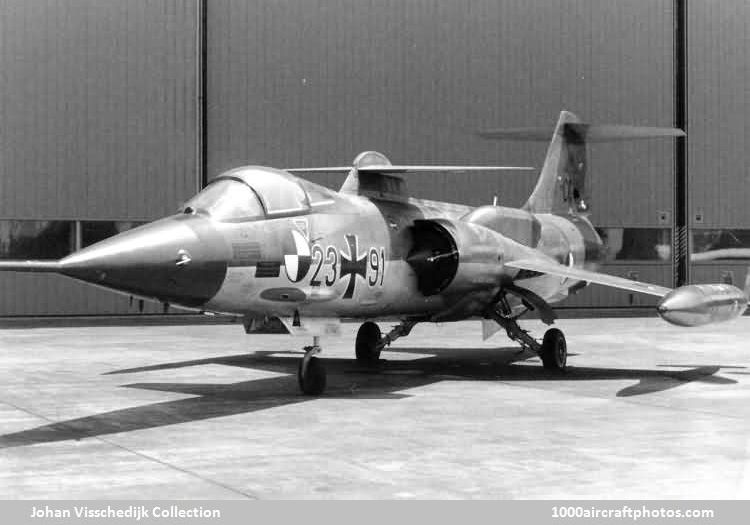10/31/2007. Remarks by Johan Visschedijk: "Messerschmitt-Bölkow-Blohm (MBB) developed this CCV (control configured vehicle) aircraft concept for the Bundesministerium der Verteidigung (German Federal Ministry of Defense). The aim was to develop and test a quadruplex-redundant electrically signalled flight-control system and to flight-test a higly unstable combat aircraft. In other words, an aircraft with "artificial" stability, i.e. stability produced by technical control methods.
The F-104G has a high inherent longitudinal static stability, and to move the overall center of pressure forward of the center of gravity by the planned 20% mean aerodynamic chord required both a jettisonable aft ballast and a canard foreplane. Stability is restored artificially by the a digital fly-by-wire flight control system. Triplex-redundant, self-monitoring actuators controlled the hydraulic actuators.
The Bundesministerium supplied a Fokker-built Lockheed F-104G Starfighter, s/n 23+91 (later re-serialed 98+36), that was modified in stages. The first test flights were made in basic, stable F-104G configuration to calibrate the aerodynamic sensors. Next, 1,323 lb (600 kg) of aft ballast was added to move the center of gravity aft towards the aerodynamic center. The aft ballast was then removed and replaced by 529 lb (240 kg) in the front fuselage, plus additional fuel in the front fuselage cell. In 1980 the canard, a complete F-104 tail plane section, was added to move the aerodynamic center forward on to the center of gravity, the bulges on the fuselage housing the actuators. The aircraft could be flown manually in these conditions.
Unstable testing began by installing 882 lb (400 kg) of ballast in the canard equipped aircraft, moving the center of gravity 10% of the mean aerodynamic chord behind the aerodynamic center. This condition was re-stabilized by jettisoning the lead shot aft ballast. The highly unstable configuration was reached by adding the full 1,455 lb (660 kg) aft ballast then rescheduling fuel usage. Fuel was kept in the tip tanks to refill the forward and main cells for emergency re-stabilization.
Between December 1977 and December 1981, MBB completed more than 120 flights. Tests covered the complete flight envelope. including supersonic speeds, in neutral, unstable and highly unstable configurations. MBB studies indicated that artificial longitudinal and directional stability would reduce overall drag by 20 to 30% while increasing overall lift, resulting in a reduction in combat-aircraft take off weight of 15% relative to a stable design.
Other advantages of active flight controls include: direct lift and side-force control to improve weapon delivery accuracy; flutter suppression to eliminate flight-envelope restrictions; gust alleviation for greater crew comfort; and gust and maneuver load control to increase airframe life. The test results from this program have been used in the conception and development of the European Fighter Aircraft that became the Eurofighter Typhoon."
Read also the CCV remarks on page 7026.
